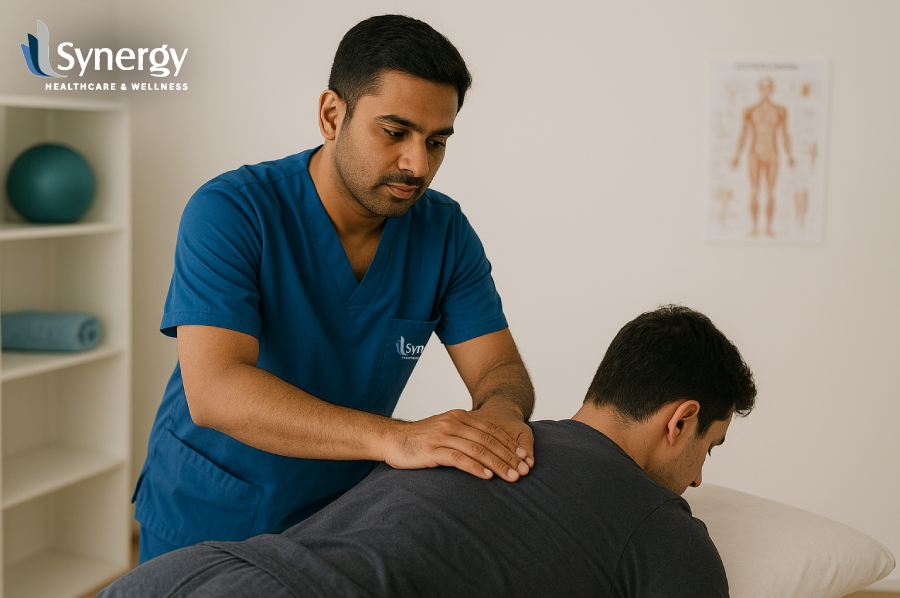Choosing between physiotherapy vs massage is not about which is better, but rather about which is most suitable for your specific situation. Physiotherapy restores movement and strength after injury or illness. Massage therapy helps relieve tension and promotes overall relaxation. By understanding the difference between massage and physiotherapy treatment goals, you can choose the right professional and set clear expectations for your body’s recovery.
Understanding the differences between physiotherapy and massage therapy can help you choose the most suitable treatment approach for your recovery and overall health. Both aim to improve physical well-being, but they use different methods, techniques, and goals. Knowing how each works allows you to make an informed decision that matches your condition and lifestyle.
What Is Physiotherapy?
Definition and Scope
Physiotherapy focuses on restoring movement, strength, and function after injury, illness, or surgery. A licensed physiotherapist assesses how your muscles, joints, and nerves work together, then develops a structured plan to improve mobility and reduce pain. This form of care is based on clinical research and medical assessment.
Typical Goals
The purpose of physiotherapy and massage differs significantly. Physiotherapy targets the root cause of physical limitations, including muscle weakness, joint stiffness, or nerve issues. Treatment often includes manual therapy, joint mobility work, and progressive strengthening exercises. Each treatment plan is tailored to individual recovery needs and is adjusted as progress continues.
Who Delivers It
Only a licensed physiotherapist with recognised academic and clinical credentials provides physiotherapy. These professionals work in hospitals, sports centres, and private practices. Their training enables them to diagnose movement disorders, create effective rehabilitation exercise programs, and guide patients through long-term recovery.
Common Conditions Treated
Physiotherapy is recommended for musculoskeletal injuries, arthritis, back and neck pain, post-surgical rehabilitation, and neurological conditions such as stroke or multiple sclerosis. It also plays a key role in preventing future injuries by improving posture and flexibility.
What Is Massage Therapy?
Definition and Scope
Massage therapy involves the manipulation of soft tissues such as muscles, tendons, and ligaments to relieve tension and promote relaxation. A licensed massage therapist employs various touch techniques to enhance circulation and promote comfort. The focus is on easing discomfort and stress rather than rebuilding movement patterns.
Typical Goals
Massage therapy is often used for muscle tension and stress relief. It helps improve blood flow, reduce soreness, and lower stress levels. It is especially useful for those dealing with fatigue, overuse injuries, or general body stiffness.
Who Delivers It
A licensed massage therapist is trained in anatomy, physiology, and methods such as soft tissue mobilisation, trigger point therapy, and soft tissue massage. While they do not diagnose injuries, they often work in collaboration with physiotherapists and doctors to complement medical treatment.
Common Conditions Treated
Massage therapy helps with tension headaches, repetitive strain injuries, post-workout soreness, and chronic stiffness. It can be part of a wellness maintenance plan or a supportive therapy alongside physiotherapy.
Physiotherapy vs Massage: Comparison
Treatment Approach
Physiotherapy and massage therapy differ most clearly in purpose and process.
- Physiotherapy begins with a movement assessment to identify the source of pain or dysfunction. Treatment then combines manual therapy with exercises, mobility drills, and sometimes equipment like ultrasound or electrical stimulation.
- Massage therapy relies mainly on touch to relax muscles and release tightness without diagnostic evaluation.
Duration and Frequency
- Physiotherapy sessions generally last between 45 and 60 minutes and are scheduled regularly over weeks or months for measurable improvement.
- Massage therapy sessions can range from 30 to 90 minutes and are often taken periodically for relaxation or recovery.
Cost Expectations
- Fees vary by condition and clinic. Physiotherapy is often more expensive because it includes evaluation, exercise prescription, and progress tracking.
- Massage therapy is typically priced per session, depending on style or intensity, such as deep tissue or sports massage.
Outcomes and Limitations
- Physiotherapy aims for long-term functional recovery, rebuilding strength, flexibility, and coordination.
- Massage therapy provides short-term comfort, easing soreness and improving relaxation.
Used together, they can produce excellent results—massage reduces tension while physiotherapy restores structure and movement.
How to Choose Between Them
Questions to Ask Yourself
Before deciding, ask what you hope to achieve.
- If pain or limited movement follows injury or surgery, physiotherapy for rehabilitation and mobility is ideal.
- If your concern is stress, fatigue, or muscle tightness, massage therapy for pain relief offers quicker comfort.
- If you are unsure, an initial evaluation with both specialists can clarify your best option.
Scenario-Based Guidance
- Post-surgery rehabilitation: Physiotherapy rebuilds muscle control and mobility.
- Chronic pain management: Physiotherapy addresses underlying causes, while massage adds relaxation benefits.
- Work-related stiffness: Massage loosens tight muscles; physiotherapy corrects posture and mechanics.
- Athletic recovery: Combine rehabilitation exercises with soft tissue massage to enhance flexibility and performance.
When Both Therapies Work Together
Many people benefit from a combined treatment plan. The physiotherapist improves movement and joint function, while the massage therapist helps keep tissues healthy between sessions. For example, a runner might use physiotherapy for gait correction and massage to reduce tension before training.
Practical Tips Before You Book
What to Check in a Clinic or Therapist
Verify that your provider is certified and has relevant experience. A licensed physiotherapist or licensed massage therapist should have recognised qualifications and positive reviews. Check whether the clinic specialises in conditions like sports injuries, post-operative recovery, or chronic pain.
What to Expect in the First Session
During physiotherapy, expect an assessment covering posture, flexibility, strength, and coordination. The therapist explains findings and outlines a plan with clear goals. In massage therapy, the first session focuses on comfort level, preferred pressure, and specific muscle areas that need attention.
How to Maximise Results
Follow all prescribed exercises between physiotherapy sessions to maintain progress. After massage therapy, gently stretch and drink water to aid in recovery. Regular communication with your therapist helps fine-tune treatment to your response and comfort.
Safety Considerations
Always share your medical history with your healthcare provider before starting any therapy. People with fractures, inflammation, or open wounds should avoid massage over those areas. Those with circulatory or heart issues should consult a doctor before starting intense physiotherapy. Both methods are safe when provided by trained professionals.
Focused Treatment, Personalised for Every Patient
Synergy Healthcare & Wellness is a specialised physiotherapy and rehabilitation centre in Chennai built on clinical expertise and patient trust. Our senior doctors and physiotherapists carry out comprehensive assessments and craft customised treatment plans focused on restoring movement and reducing pain. We maintain exacting standards in care delivery and emphasise consistent progress through evidence-based methods. With branches in Anna Nagar, T Nagar and Adyar, we serve diverse communities across the city. Whether you are recovering from surgery, managing chronic pain or aiming for better mobility, our team supports you through each stage of recovery.
Takeaway
The choice between physiotherapy and massage therapy depends on your condition and goals. Physiotherapy focuses on diagnosing, strengthening, and restoring movement. Massage therapy focuses on promoting relaxation, improving circulation, and alleviating tension. When combined thoughtfully, they complement each other. Physiotherapy addresses the root cause, while massage therapy helps maintain comfort and promote recovery.
If you are recovering from an injury, experiencing limited mobility, or managing chronic pain, consider consulting a physiotherapist. If your primary goal is stress reduction or muscle relaxation, a massage therapist can assist you. Many individuals discover that alternating between the two provides the most comprehensive balance of care.
FAQ’s
Is Massage Therapy the Same as Physiotherapy?
No. Massage therapy and physical therapy differ in purpose. Massage focuses on relaxation and soft-tissue recovery, while physiotherapy targets function, movement, and long-term rehabilitation.
How Long Does Treatment Take?
Recovery time in physiotherapy varies depending on the type and severity of the injury. Some conditions improve within weeks, while others require months. Massage therapy can be scheduled as often as needed for maintenance or stress relief.
Does Insurance cover these Therapies?
In many regions, physiotherapy is covered by health insurance when prescribed by a doctor. Coverage for massage therapy depends on the provider and policy.
Which Works Best for Sports Injuries or Posture Problems?
Physiotherapy for sports injuries helps strengthen muscles and correct abnormal movement patterns. Massage therapy for stress and muscle tension helps prevent strain and improve recovery. Both can be used together for balanced results.












